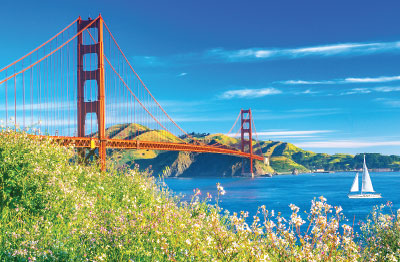Golden Gate Bridge Wows With Sweeping Arches, Stunning Views
Abstract
No trip to San Francisco is complete without a trek across the Golden Gate Bridge. Built during the Great Depression, the bridge is a marvel of engineering, construction, and design.
With its sweeping arches and art deco styling, the Golden Gate Bridge is arguably one of the most beautiful and most photographed bridges in the world. The bridge is painted an orange vermillion dubbed International Orange to make it stand out against the spectacular backdrop of sea, land, and fog.

It spans almost two miles across the Golden Gate, the narrow strait where San Francisco Bay opens to meet the Pacific Ocean. Prior to the opening of the bridge in 1937, San Francisco was the largest city in the United States reached primarily by ferry boat.
Aside from its iconic beauty, the bridge is considered a marvel of engineering: its suspension design allows it to move more than two feet laterally to withstand strong bay winds. The Golden Gate Bridge was named one of the “Seven Wonders of the Modern World” by the American Society of Civil Engineers.
It is said that everyone should experience walking across the Golden Gate Bridge at least once in their lifetime. Its pedestrian walkway allows walkers and bikers to experience the bridge and peer down some 22 stories to the water below.
More information about the history, science, and engineering of the bridge’s construction can be found in the interactive exhibits at the bridge’s Welcome Center and outdoor plaza. On Thursdays and Sundays, the San Francisco City Guides—a nonprofit associated with the San Francisco Public Library—offers free educational walking tours of the bridge.
The bridge spills into Golden Gate Park, an attraction in its own right, with more than 1,000 amazing acres of beauty covering more than 50 city blocks. Its attractions number more than can be seen in a day, with some highlights including a Japanese tea garden, a flower conservatory, botanical gardens, a science museum, an aquarium, the de Young Museum, and a buffalo paddock where visitors can watch a herd of bison. While the park is free to visit during the day, popular attractions charge admission. ■



